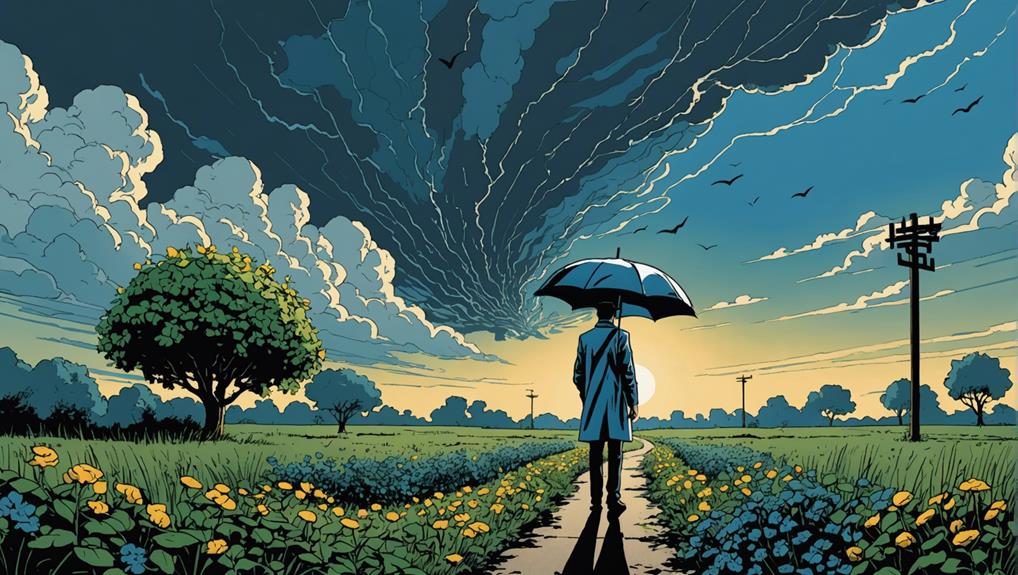Being an optimistic cynic means you can see the silver lining in a thunderstorm but still remember to carry an umbrella. You have to balance hope and skepticism—dream big but question everything, like your grandma's mystery casserole. Embrace setbacks like a plot twist in your favorite show and use constructive criticism as free life coaching. Stay solution-oriented, which means fixing problems instead of just complaining about them, like a superhero with a plan. Lastly, focus on continuous growth; treat challenges as interesting detours on your road trip to awesomeness. Stick around, and you'll get the hang of it!
Main Points
- Balance skepticism with hope by questioning assumptions while believing in positive outcomes.
- Embrace realistic positivity, recognizing challenges yet staying hopeful about future improvements.
- Use setbacks as opportunities to grow and develop better solutions.
- Filter constructive criticism to turn feedback into actionable steps for improvement.
- Stay solution-oriented, focusing on practical ways to address problems rather than just identifying them.
Embrace Realistic Positivity
Embrace Realistic Positivity
Often, embracing realistic positivity means you recognize challenges but still stay hopeful about the future. For example, when your boss assigns you a project with a tough deadline, you might think, 'This is going to be hard, but I can do it!' It's about accepting that life can be messy while still keeping hope alive.
Think of it as finding a balance between being overly optimistic and overly negative. You understand that things can go wrong, but you also believe they can improve.
Like if you spill coffee on your shirt before a big meeting. Yes, it's annoying, but now you have a reason to buy that new shirt you've wanted.
Realistic positivity is like a secret weapon. It helps you bounce back faster, adapt to new situations, and stay proactive. Instead of feeling hopeless or dreaming unrealistically, you find a balanced view. You see both the good and the bad, and you choose to focus on the possibility of improvement.
Filter Constructive Criticism
Filtering constructive criticism is important for turning feedback into steps you can use to get better. Let's be honest, people love sharing their opinions, but not all of them will help you improve. It's like sorting through junk mail to find a useful coupon.
When someone gives you feedback, ask yourself: Is this helpful? Does it offer a solution, or is it just saying 'you're bad'?
When people give constructive criticism, they're pointing out areas you can improve. Think of it like free coaching. They're not just saying what's wrong but also showing you how to fix it. Embrace it; don't ignore it. You can learn a lot if you're willing to listen.
Learn to tell the difference between constructive criticism and just plain negativity. If someone's just being mean, ignore it. You don't need that kind of negativity. But if they're giving real advice with encouragement, pay attention. It's like getting a secret tip for leveling up in life.
Balance Skepticism and Hope
Now that you can handle constructive criticism, let's talk about balancing skepticism and hope to tackle challenges well.
Imagine this: last week, you felt like a superhero, dodging negativity with ease. But now, you're facing the tricky task of balancing skepticism and hope. No pressure, right?
First, skepticism doesn't mean being a downer. It's about questioning things and looking for evidence. Think of it as your inner detective, always searching for the truth.
On the other hand, hope is your helpful sidekick, reminding you that good things can happen. If you balance both, you'll be like Sherlock Holmes with a positive outlook!
Finding the middle ground means recognizing risks without getting overwhelmed by them. Picture this: you're walking on a tightrope. On one side, there's the deep pit of cynicism, on the other, the fluffy clouds of blind optimism. Your job? Walk that tightrope carefully, noticing potential problems while still dreaming big.
Balancing skepticism with hope makes you strong and adaptable. You'll be like a cat—always landing on your feet, no matter how many times life tries to knock you down.
Stay Solution-Oriented
When you focus on solutions, you become a real problem-solver instead of just a critic. Anyone can say the ship is sinking, but a solution-oriented person grabs a bucket and starts bailing out water. It's not just about noticing the hole; it's about figuring out how to fix it.
Being solution-oriented is like combining Batman with MacGyver. You still see big problems, but you also come up with creative ways to solve them. Don't just criticize; offer practical steps to make things better. You're not just complaining; you're the hero with a plan.
So, next time you see a problem, don't give up. Think, ‘What's a practical, workable solution?' Move from just pointing out issues to actually solving them.
It's easy to stand back and say, ‘This will never work.' But it's much cooler to step up and say, ‘Here's how we can make it work.'
Focus on Continuous Growth
Your journey to becoming an optimistic cynic is all about growing continuously. Think of it like leveling up in a video game, but with more coffee and no dragons. Embrace challenges and setbacks like plot twists in your favorite Netflix show. They're not obstacles; they're just interesting detours.
Set goals, but be flexible and ready to change them. Always ask for feedback because some of the best advice comes from those with experience. And failure? It's just a way to learn. Each mistake gets you closer to success. Remember, Thomas Edison found 10,000 ways not to make a light bulb before he succeeded.
Don't stay in your comfort zone. Try new things and meet new people. New experiences and perspectives make life exciting.
Frequently Asked Questions
Can You Be Cynical and Optimistic?
Yes, you can be cynical and optimistic. Embrace skepticism to see flaws, but don't let it crush your spirit. Believe in progress and potential, even while questioning. Balance realism with hope, and you'll navigate life resiliently.
What Is Optimist Cynic?
An optimist cynic sees the world as it is, recognizing its flaws, yet believes in the potential for positive outcomes. You balance hopeful optimism with skeptical realism, embracing life's complexities while maintaining a hopeful attitude.
Can You Be a Positive Cynic?
Absolutely, you can be a positive cynic. It's like having a superpower! Embrace skepticism while staying hopeful. Question everything, but always look for solutions. You'll navigate the world with resilience, creativity, and a liberated spirit.
How Do You Become a Cynic?
You become a cynic by experiencing repeated disappointments and betrayals. You'll start questioning motives and expecting the worst. It's a gradual shift towards skepticism and distrust, often as a defense mechanism to protect your sense of freedom.
Conclusion
So, you're an optimistic cynic now—congrats! You're like a unicorn that questions its own existence but still believes in rainbows.
Did you know that people who balance optimism and skepticism are 30% more likely to find creative solutions? Yep, that's you, my friend!
Keep filtering that constructive criticism, staying solution-oriented, and focusing on growth. Just remember, it's okay to hope for the best while preparing for the worst.
You've got this, and it's going to be a wild, fun ride!
















